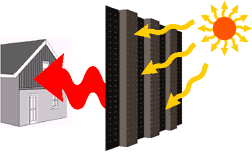Transpired Solar Collectors
Many commercial and industrial buildings need to have high ventilation rates to ensure adequate indoor air quality. However, heating all that fresh air can be very expensive. Now an elegantly simple technology is available to use solar energy to preheat ventilation air and dramatically reduce energy use and expenditures.

Transpired solar air collector systems consist of a dark-colored, perforated facade installed on a building's south-facing wall. An added fan or the building's existing ventilation system draws ventilation air into the building through the perforations and the air space between the facade and the main building wall. Solar energy absorbed by the dark facade and transferred to the air flowing through it can preheat the intake air by as much as 40°F. Reduced heating costs can pay for the system in three to twelve years.
A transpired solar collector does not just heat the air for a building. It can help cool the building as well. During summer months the ventilation fans draw in the hot air. Instead of bringing this hot air into the building, bypass dampers are used to move the hot air back outside. This hot air then does not come in direct contact with the inner wall, thus making the building cooler.
Transpired solar collectors are primarily used to heat air for office buildings, schools, homes, and industrial facilities. While the technology can be used in most buildings, it is really useful for buildings that are used by industry, commercial interests, and institutional interests. Such buildings usually need a lot of ventilation, and this technology can be extremely helpful in such circumstances.
Transpired solar collectors can be used to preheat combustion air for industrial furnaces. In an agricultural setting this technology can be used to create hot air for crop drying.
As a means of heating air, transpired solar collectors are very inexpensive to make and very efficient. They preheat air twice as effectively as any other type of solar heater. Transpired solar collectors can use as much as 80 percent of the solar energy that comes into contact with the collector. The use of a transpired solar collector can result in much lower energy costs for the building to which it is attached.
Transpired solar collectors can be used in parts of the world where there is not a significant amount of direct sunlight. For example, this solar technology can be used in Canada and the northern United States. Snowfall can actually make the transpired solar collector heat better. When snow covers the ground, it can reflect as much as 70 percent more solar radiation onto the transpired solar collector. More reflected solar radiation results in more heat produced. In addition, transpired solar collectors do not need as much additional heating as other solar heating systems when there is no sunlight. The heat that is collected during the day can be retained and used after dark.
Transpired Solar Collectors copyright 2011 Digtheheat.com

